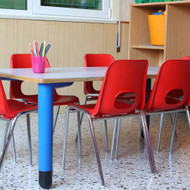Seating Chart Tips
Apr 11th 2019

Consider your purpose for creating a seating chart:
- Is it to control talking?
- Is it to increase focus of students?
- Is it to encourage group work and dialogue?
- Is it to create pathways for you to monitor?
Your purpose should drive the way you arrange your room.
Some suggestions when making your chart:
- Make your chart BEFORE the students enter the room.
Consider drawing a template, write in the names, and keep it in your plan book, grade book, etc. Another option is to place small sticky notes with student names written on them on a seating chart grid, and put the chart into a plastic page protector. This is wonderful because it's so easy to change seats.
- Let students know in a neutral tone they will be placed in assigned seats.
“I am going to put you in a seating arrangement as we study this unit/concept, etc. Some of you may or may not be pleased with your seat at first, but remember it is my job to help you learn and that includes putting you in a spot that supports your learning. This seat will not be forever so I would appreciate your cooperation.”
Tip:
Prepare yourself for their complaints, especially in the upper grades. Choose to ignore the complaints and proceed into the next part of your lesson. If a student can’t settle down, calmly ask them to write down their complaint and where they would rather sit. Do not stall your lesson by entertaining the complaining at this time. Once you collect their thoughts, remember to read and respond to it by the next day.
Getting Started:
- Think about your high needs (behavior & academic) students and put them in place first.
- Think about less needy students who are not annoyed with the talkers and surround the talkers with the responsible students. Fill in remaining students using this strategy.
- Move friends away from each other (by sight).
- Students who always want/need more attention should be closer to the front/you so they do not disrupt everyone while trying to get your attention.
- Have a few isolated seats available and empty so you can move students as needed into them and let them start fresh the next day in their regular seat.
- Make sure NO ONE has his or her back to the screen/directions. If you have grouped desks together, angle them so all students can see the board/screen while working. You need to see their eyes while you instruct. If you cannot see their eyes, move them or move yourself.

